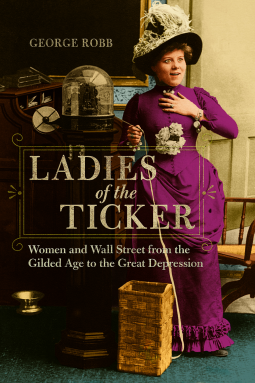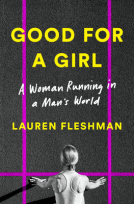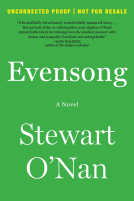Please wait... This may take a moment.
Ladies of the Ticker
Women and Wall Street from the Gilded Age to the Great Depression
by George Robb
This title was previously available on NetGalley and is now archived.
Pub Date
Aug 15 2017
| Archive Date
Sep 12 2017
Description
Long overlooked in histories of finance, women played an essential role in areas such as banking and the stock market during the late nineteenth and early twentieth centuries. Yet their presence sparked ongoing controversy. Hetty Green's golden touch brought her millions, but she outraged critics with her rejection of domesticity. Progressives like Victoria Woodhull, meanwhile, saw financial acumen as more important for women than the vote.
George Robb's pioneering study sheds a light on the financial methods, accomplishments, and careers of three generations of women. Plumbing sources from stock brokers' ledgers to media coverage, Robb reveals the many ways women invested their capital while exploring their differing sources of information, approaches to finance, interactions with markets, and levels of expertise. He also rediscovers the forgotten women bankers, brokers, and speculators who blazed new trails--and sparked public outcries over women's unsuitability for the predatory rough-and-tumble of market capitalism. Entertaining and vivid with details, Ladies of the Ticker sheds light on the trailblazers who transformed Wall Street into a place for women's work.
Long overlooked in histories of finance, women played an essential role in areas such as banking and the stock market during the late nineteenth and early twentieth centuries. Yet their presence...
Description
Long overlooked in histories of finance, women played an essential role in areas such as banking and the stock market during the late nineteenth and early twentieth centuries. Yet their presence sparked ongoing controversy. Hetty Green's golden touch brought her millions, but she outraged critics with her rejection of domesticity. Progressives like Victoria Woodhull, meanwhile, saw financial acumen as more important for women than the vote.
George Robb's pioneering study sheds a light on the financial methods, accomplishments, and careers of three generations of women. Plumbing sources from stock brokers' ledgers to media coverage, Robb reveals the many ways women invested their capital while exploring their differing sources of information, approaches to finance, interactions with markets, and levels of expertise. He also rediscovers the forgotten women bankers, brokers, and speculators who blazed new trails--and sparked public outcries over women's unsuitability for the predatory rough-and-tumble of market capitalism. Entertaining and vivid with details, Ladies of the Ticker sheds light on the trailblazers who transformed Wall Street into a place for women's work.
Advance Praise
"A well-written and insightful description of the
under-researched role of women investors and financiers in Wall Street's
heyday."--Janette Rutterford, coeditor of Women and their Money, 1700 to
1950
"George Robb’s Ladies of the Ticker fills a significant
gap in the history of capitalism, establishing through extensive archival
research that women were active as investors in late nineteenth and early
twentieth-century America. Crucially, Robb shows that economic and cultural
histories are inseparable. Drawing with authoritative knowledge on a range of
journalistic and literary texts, he explores the disjunction between
representations of women as financially inept and the reality of their often
competent and shrewd participation in an increasingly democratized stock
market. The book is clear, accessible, and enjoyable to read. It is a major
contribution to economic history and American history generally."--Nancy
Henry, University of Tennessee
"A well-written and insightful description of the
under-researched role of women investors and financiers in Wall Street's
heyday."--Janette Rutterford, coeditor of Women and their Money, 1700 to...
Advance Praise
"A well-written and insightful description of the
under-researched role of women investors and financiers in Wall Street's
heyday."--Janette Rutterford, coeditor of Women and their Money, 1700 to
1950
"George Robb’s Ladies of the Ticker fills a significant
gap in the history of capitalism, establishing through extensive archival
research that women were active as investors in late nineteenth and early
twentieth-century America. Crucially, Robb shows that economic and cultural
histories are inseparable. Drawing with authoritative knowledge on a range of
journalistic and literary texts, he explores the disjunction between
representations of women as financially inept and the reality of their often
competent and shrewd participation in an increasingly democratized stock
market. The book is clear, accessible, and enjoyable to read. It is a major
contribution to economic history and American history generally."--Nancy
Henry, University of Tennessee
Available Editions
| EDITION |
Paperback |
| ISBN |
9780252082719 |
| PRICE |
$24.95 (USD)
|
| PAGES |
280
|
Additional Information
Available Editions
| EDITION |
Paperback |
| ISBN |
9780252082719 |
| PRICE |
$24.95 (USD)
|
| PAGES |
280
|
Average rating from 19 members
Featured Reviews
 Deborah W, Reviewer
Deborah W, Reviewer
5 stars
5 stars
5 stars
5 stars
5 stars
"Ladies of the Ticker" is a history of women involved in the American stock market from around the 1880s to 1920s. The author started by describing the laws (in England and America) that made it difficult for women to control and invest their own money and the changes that came about in the late 1800s that allowed more women to invest in stocks and bonds.
The rest of the book focused "the Gilded Age to the Great Depression." He started by describing how novels, magazines, financial manuals, and similar sources portrayed the stock market and women who invested in bonds or stocks. He then looked at records from two stock brokers showing what women actually invested their money in, their investment habits, and how they acted in their correspondence with the stock broker. He acknowledged that women didn't all behave the same way, yet there were certain general trends. He contrasted women's investment behavior to the records of men's investments and to how popular culture portrayed women investors.
The author also talked about fraud (involving banks, stocks, and bonds) that was directed at women or that was done by women. He looked at the women's rights movement and how they promoted financial education and empowerment for women. He talked about early women brokers, capitalists, and financiers. Some parts read like biographies. We're told about several women who tried to set up as a stock brokers, what the press and such said about the woman, what she said about her past, and what we know about what happened to her. We also learned details about several women who carried out sensational financial frauds.
This book had an academic tone. As in, I felt like the topic had been carefully researched and a balanced view presented. As a woman who is interested in this time period and who invests in stocks, I found it very interesting. Overall, I'd recommend this book.
5 stars
5 stars
5 stars
5 stars
5 stars
 Librarian 121315
Librarian 121315
4 stars
4 stars
4 stars
4 stars
4 stars
The book I would have liked to have read when I took my class of Women’s Studies back in college. The book will appeal to those who like to read about history and particularly women’s history. The book is not long so a lot is said in a few pages which I personally liked. A look at the history of women in finances is an interesting subject and I am sure college professors in women’s studies shall take more than a passing look at this book. Some pictures and illustrations are shown throughout the book; I would have liked to have seen more of these pictures; particularly because today’s audiences are very visual so they have come to expect that.
4 stars
4 stars
4 stars
4 stars
4 stars
 Tiffany T, Educator
Tiffany T, Educator
3 stars
3 stars
3 stars
3 stars
3 stars
A well written, well-researched examination of how women have been viewed in the financial echelon of society. I felt Robb touched on an aspect of history that is often woefully neglected with skill and insight. One I will be recommending to friends. I thank NetGalley and the publisher for the opportunity to get an e-book Arc.
3 stars
3 stars
3 stars
3 stars
3 stars
 Mandy J, Reviewer
Mandy J, Reviewer
5 stars
5 stars
5 stars
5 stars
5 stars
I thought at first that this was going to be quite a dry academic text but in fact it’s a lively and accessible exploration of a hitherto largely ignored area of social history – the relationship of women to finance, in this case in America and over the period from the gilded Age to the Great Depression. In this thoroughly researched and well-written account, we discover that far from merely being stuck at home, powerless and ignorant, many women did in fact play an active role in financial markets, becoming adept at banking, the stock market, investment, speculation and even in some cases financial fraud. They ventured out into the cut and thrust of a largely male domain and proved themselves equal at making money. Capitalism, it turns out, doesn’t have to be a male preserve, although even in our own times it pretty much still is. I particularly enjoyed discovering some of the characters who operated in this man’s world, and also seeing how they were portrayed in popular culture, form Henry James to weekly magazines. It’s a fascinating story, and one which I very much enjoyed reading.
5 stars
5 stars
5 stars
5 stars
5 stars
 Abby S, Reviewer
Abby S, Reviewer
5 stars
5 stars
5 stars
5 stars
5 stars
Terrific look at this group of women real women whose careers on Wall Street were leaders at the forefront of women working in finance.These women come alive and Infound this a very interesting read.#netgalley#uofillinoispress,
5 stars
5 stars
5 stars
5 stars
5 stars
Featured Reviews
 Deborah W, Reviewer
Deborah W, Reviewer
5 stars
5 stars
5 stars
5 stars
5 stars
"Ladies of the Ticker" is a history of women involved in the American stock market from around the 1880s to 1920s. The author started by describing the laws (in England and America) that made it difficult for women to control and invest their own money and the changes that came about in the late 1800s that allowed more women to invest in stocks and bonds.
The rest of the book focused "the Gilded Age to the Great Depression." He started by describing how novels, magazines, financial manuals, and similar sources portrayed the stock market and women who invested in bonds or stocks. He then looked at records from two stock brokers showing what women actually invested their money in, their investment habits, and how they acted in their correspondence with the stock broker. He acknowledged that women didn't all behave the same way, yet there were certain general trends. He contrasted women's investment behavior to the records of men's investments and to how popular culture portrayed women investors.
The author also talked about fraud (involving banks, stocks, and bonds) that was directed at women or that was done by women. He looked at the women's rights movement and how they promoted financial education and empowerment for women. He talked about early women brokers, capitalists, and financiers. Some parts read like biographies. We're told about several women who tried to set up as a stock brokers, what the press and such said about the woman, what she said about her past, and what we know about what happened to her. We also learned details about several women who carried out sensational financial frauds.
This book had an academic tone. As in, I felt like the topic had been carefully researched and a balanced view presented. As a woman who is interested in this time period and who invests in stocks, I found it very interesting. Overall, I'd recommend this book.
5 stars
5 stars
5 stars
5 stars
5 stars
 Librarian 121315
Librarian 121315
4 stars
4 stars
4 stars
4 stars
4 stars
The book I would have liked to have read when I took my class of Women’s Studies back in college. The book will appeal to those who like to read about history and particularly women’s history. The book is not long so a lot is said in a few pages which I personally liked. A look at the history of women in finances is an interesting subject and I am sure college professors in women’s studies shall take more than a passing look at this book. Some pictures and illustrations are shown throughout the book; I would have liked to have seen more of these pictures; particularly because today’s audiences are very visual so they have come to expect that.
4 stars
4 stars
4 stars
4 stars
4 stars
 Tiffany T, Educator
Tiffany T, Educator
3 stars
3 stars
3 stars
3 stars
3 stars
A well written, well-researched examination of how women have been viewed in the financial echelon of society. I felt Robb touched on an aspect of history that is often woefully neglected with skill and insight. One I will be recommending to friends. I thank NetGalley and the publisher for the opportunity to get an e-book Arc.
3 stars
3 stars
3 stars
3 stars
3 stars
 Mandy J, Reviewer
Mandy J, Reviewer
5 stars
5 stars
5 stars
5 stars
5 stars
I thought at first that this was going to be quite a dry academic text but in fact it’s a lively and accessible exploration of a hitherto largely ignored area of social history – the relationship of women to finance, in this case in America and over the period from the gilded Age to the Great Depression. In this thoroughly researched and well-written account, we discover that far from merely being stuck at home, powerless and ignorant, many women did in fact play an active role in financial markets, becoming adept at banking, the stock market, investment, speculation and even in some cases financial fraud. They ventured out into the cut and thrust of a largely male domain and proved themselves equal at making money. Capitalism, it turns out, doesn’t have to be a male preserve, although even in our own times it pretty much still is. I particularly enjoyed discovering some of the characters who operated in this man’s world, and also seeing how they were portrayed in popular culture, form Henry James to weekly magazines. It’s a fascinating story, and one which I very much enjoyed reading.
5 stars
5 stars
5 stars
5 stars
5 stars
 Abby S, Reviewer
Abby S, Reviewer
5 stars
5 stars
5 stars
5 stars
5 stars
Terrific look at this group of women real women whose careers on Wall Street were leaders at the forefront of women working in finance.These women come alive and Infound this a very interesting read.#netgalley#uofillinoispress,
5 stars
5 stars
5 stars
5 stars
5 stars
Readers who liked this book also liked:
Good for a Girl
Lauren Fleshman
Biographies & Memoirs, Nonfiction (Adult), Sports
Evensong
Stewart O'Nan
General Fiction (Adult), Literary Fiction, Women's Fiction
Same
Hannah Rosenberg
Poetry & Verse
On Loneliness
The School of Life, Julia Hawkins
Arts & Photography, Self-Help
Joyride
Susan Orlean
Biographies & Memoirs, Nonfiction (Adult)
Letter from Japan
Marie Kondo; Marie Iida
Biographies & Memoirs, Multicultural Interest, Travel

 Deborah W, Reviewer
Deborah W, Reviewer
 Librarian 121315
Librarian 121315
 Tiffany T, Educator
Tiffany T, Educator
 Mandy J, Reviewer
Mandy J, Reviewer


















